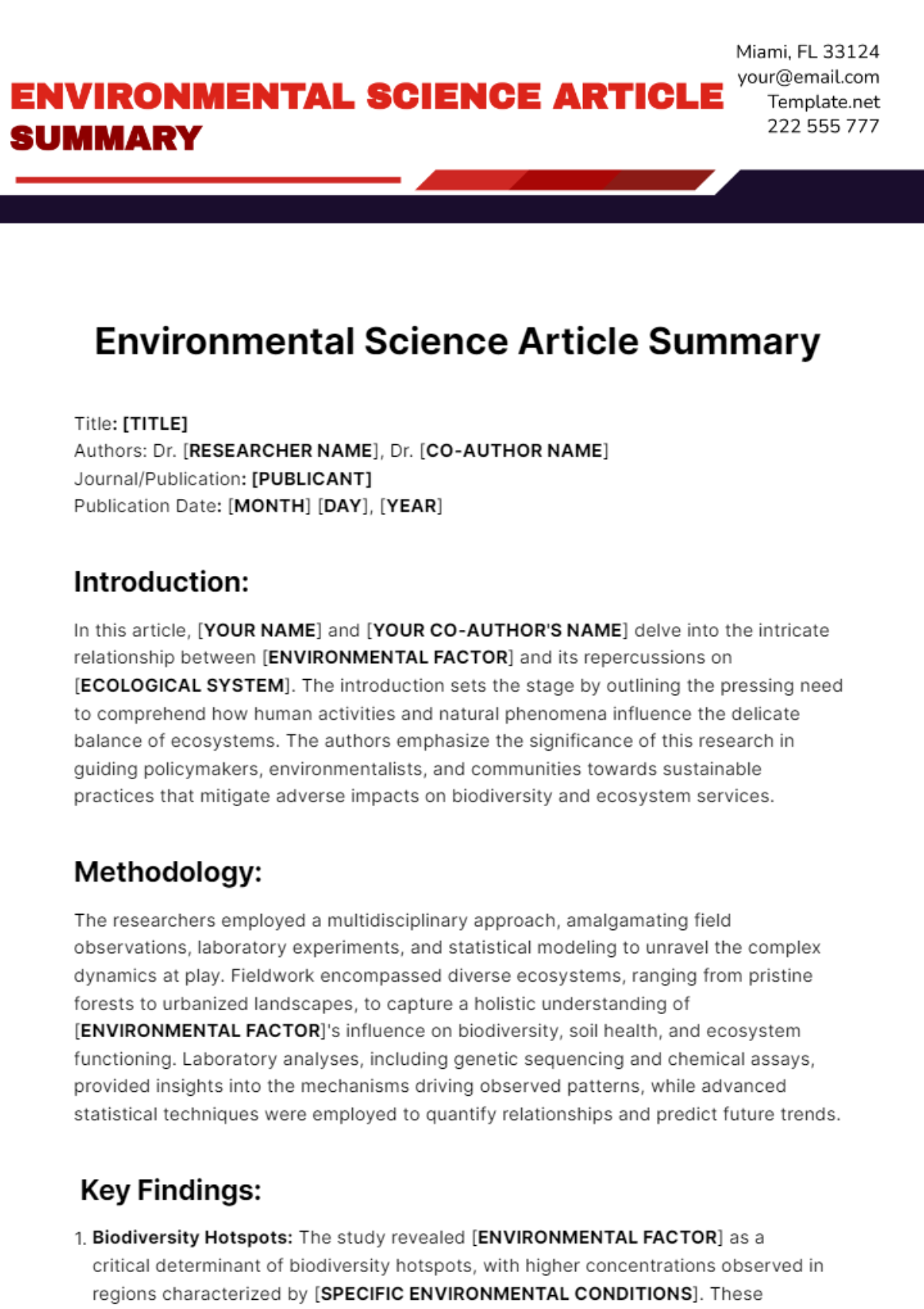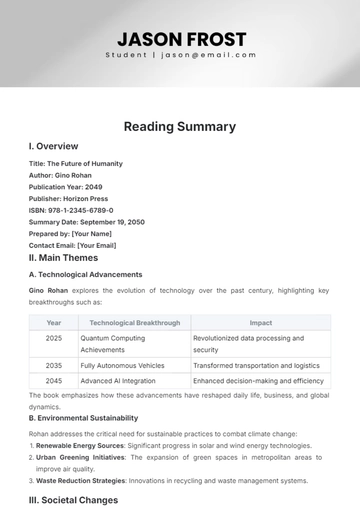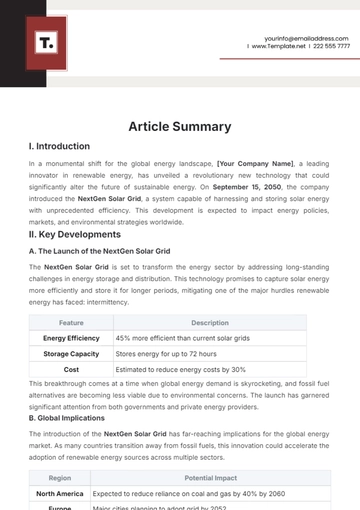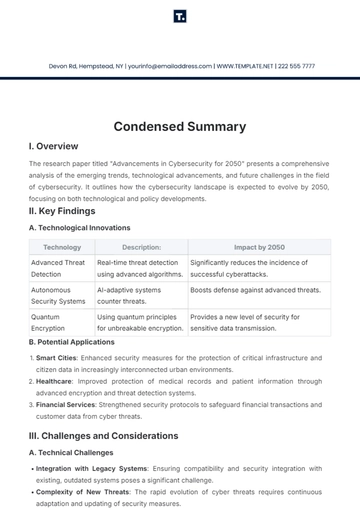Free Environmental Science Article Summary

Title: [TITLE]
Authors: Dr. [RESEARCHER NAME], Dr. [CO-AUTHOR NAME]
Journal/Publication: [PUBLICANT]
Publication Date: [MONTH] [DAY], [YEAR]
Introduction:
In this article, [YOUR NAME] and [YOUR CO-AUTHOR'S NAME] delve into the intricate relationship between [ENVIRONMENTAL FACTOR] and its repercussions on [ECOLOGICAL SYSTEM]. The introduction sets the stage by outlining the pressing need to comprehend how human activities and natural phenomena influence the delicate balance of ecosystems. The authors emphasize the significance of this research in guiding policymakers, environmentalists, and communities towards sustainable practices that mitigate adverse impacts on biodiversity and ecosystem services.
Methodology:
The researchers employed a multidisciplinary approach, amalgamating field observations, laboratory experiments, and statistical modeling to unravel the complex dynamics at play. Fieldwork encompassed diverse ecosystems, ranging from pristine forests to urbanized landscapes, to capture a holistic understanding of [ENVIRONMENTAL FACTOR]'s influence on biodiversity, soil health, and ecosystem functioning. Laboratory analyses, including genetic sequencing and chemical assays, provided insights into the mechanisms driving observed patterns, while advanced statistical techniques were employed to quantify relationships and predict future trends.
Key Findings:
Biodiversity Hotspots: The study revealed [ENVIRONMENTAL FACTOR] as a critical determinant of biodiversity hotspots, with higher concentrations observed in regions characterized by [SPECIFIC ENVIRONMENTAL CONDITIONS]. These hotspots not only harbor unique species assemblages but also provide invaluable ecosystem services essential for human well-being.
Ecosystem Resilience: Contrary to initial assumptions, certain ecosystems exhibited remarkable resilience to [ENVIRONMENTAL FACTOR], displaying adaptive mechanisms that buffer against adverse effects. This resilience underscores the importance of preserving intact ecosystems and restoring degraded ones to enhance their capacity to withstand environmental stressors.
Community Engagement: The research highlighted the pivotal role of community engagement in fostering sustainable practices and enhancing ecosystem resilience. Through participatory approaches and knowledge co-creation, local communities were empowered to become stewards of their environment, fostering a sense of ownership and responsibility towards conservation efforts.
Implications and Recommendations:
Policy Integration: Integrating findings into policy frameworks is paramount to ensure informed decision-making and proactive conservation strategies. Policymakers are urged to prioritize ecosystem protection and restoration, incorporating scientific evidence into legislation and land-use planning initiatives.
Education and Outreach: Public awareness campaigns and educational programs are essential to bridge the gap between scientific knowledge and societal action. By fostering environmental literacy and instilling a sense of environmental stewardship, communities can actively contribute to conservation efforts and sustainable development.
Research Priorities: The study identifies several key research priorities, including [SPECIFIC RESEARCH AREAS], to further elucidate the complex interactions between [ENVIRONMENTAL FACTOR] and [ECOLOGICAL SYSTEM]. Collaboration among scientists, policymakers, and stakeholders is essential to address knowledge gaps and devise effective management strategies.
Conclusion:
In conclusion, [YOUR NAME] and [YOUR CO-AUTHOR'S NAME] underscore the urgent need for concerted action to address the escalating threats posed by [ENVIRONMENTAL FACTOR] to [ECOLOGICAL SYSTEM]. By adopting a multidisciplinary approach, engaging stakeholders, and integrating scientific findings into policy and practice, we can safeguard biodiversity, enhance ecosystem resilience, and pave the way towards a more sustainable future for generations to come.
- 100% Customizable, free editor
- Access 1 Million+ Templates, photo’s & graphics
- Download or share as a template
- Click and replace photos, graphics, text, backgrounds
- Resize, crop, AI write & more
- Access advanced editor
Introducing Template.net's Environmental Science Article Summary Template. Crafted for efficiency, it's fully editable and customizable to suit your needs. With seamless integration into our Ai Editor Tool, analyzing and summarizing environmental science articles becomes a breeze. Streamline your research process and elevate your understanding effortlessly with this versatile template.





























